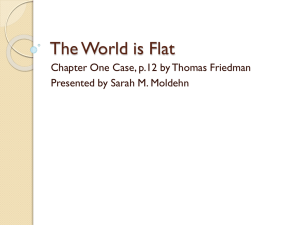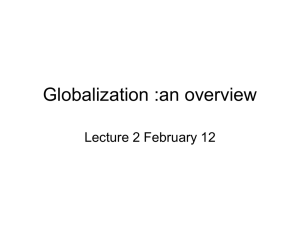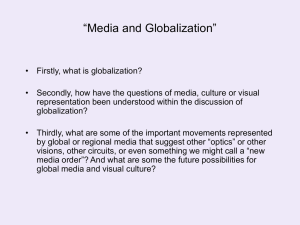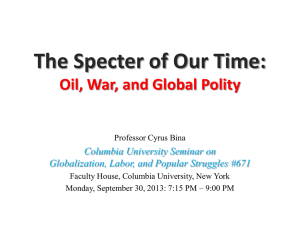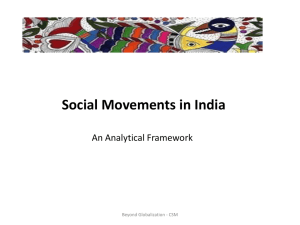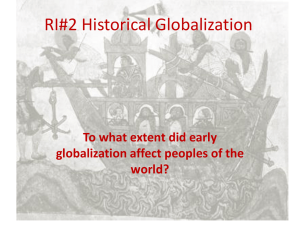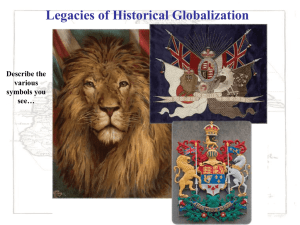Globalization Power Point Presentation
advertisement
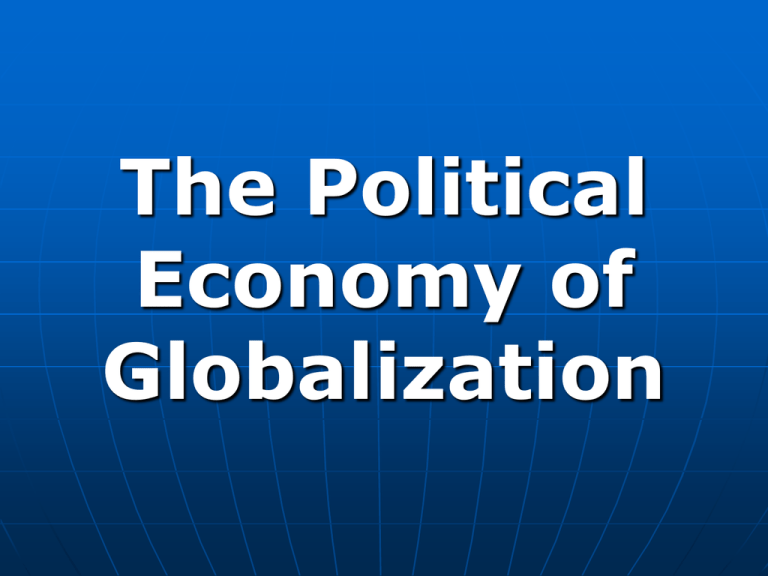
The Political Economy of Globalization Globalization Defined Globalization broadly refers to the expansion of global linkages, the organization of social life on a global scale, and the growth of a global consciousness, hence to the consolidation of world society… Globalization Defined …Such a definition captures much of what the term commonly means, but its meaning is disputed. It encompasses several large processes; definitions differ in what they emphasize. Globalization Defined …Globalization is historically complex; definitions vary in the particular driving force they identify. The meaning of the term is itself a topic in global discussion; it may refer to “real” processes, to ideas that justify them, or to a way of thinking about them… Globalization Defined …The term is not neutral! Definitions express different assessments of global change. Among critics of capitalism and global inequality, globalization now has an especially pejorative ring. Globalization Defined Do you get it??? Globalization Defined How about an easier definition…something that makes sense that I can understand…OK then, let’s try this…. Globalization Defined Question: What is Globalization? Answer: Princess Diana’s death. Question: How come? Answer: An English princess… …with an Egyptian boyfriend… …crashes in a French tunnel… …riding in a German car… …with a Dutch engine… …driven by a Belgian chauffeur… …who was drunk on Scottish whiskey… …followed closely by Italian paparazzi… …on Japanese motorcycles… …she was treated by an American doctor… …using Brazilian medicines… …All this interesting information has been supplied to you by a Brit… …using American Apple technology… …And you’re probably reading this on a Chinese-made computer… …that uses Taiwanese chips… …and a Korean monitor… …assembled by Bangladeshi workers… …in a Singapore plant… …transported by Pilipino sailors…working on Greek ships… …hijacked by Somali pirates… …released by French mercenaries… …then unloaded by Romanian dock workers in Rotterdam… …and brought to your store by Bulgarian truck drivers… …where you buy it from a Polish sales assistant… …and that, my friends, is Globalization!!! But seriously…. The following definitions represent currently influential views from academia: Friedman, The Lexus and the Olive Tree, 1999 “[T]he inexorable integration of markets, nation-states, and technologies to a degree never witnessed before in a way that is enabling individuals, corporations and nation-states to reach around the world farther, faster, deeper and cheaper than ever before…the spread of free-market capitalism to virtually every country in the world.” Robertson, Globalization, 1992 “The compression of the world and the intensification of consciousness of the world as a whole…concrete global interdependence and consciousness of the global whole in the twentieth century.” Waters, Globalization, 1995 “A social process in which the constraints of geography on social and cultural arrangements recede and in which people become increasingly aware that they are receding.” Albrow, The Global Age, 1996 “The historical transformation constituted by the sum of particular forms and instances of …[m]aking or being made global (i) by the active dissemination of practices, values, technology and other human products throughout the globe (ii) when global practices and so on exercise an increasing influence over people’s lives (iii) when the globe serves as a focus for, or a premise in shaping human activities.” McMichael, Development and Social Change, 2000 “Integration on the basis of a project pursuing ‘market rule on a global scale’”. Mittelman, The Globalization Syndrome, 2000 “As experienced from below, the dominant form of globalization means a historical transformation: in the economy, of livelihoods and modes of existence; in politics a loss in the degree of control exercised locally…and in culture, a devaluation of a collectivity’s achievements… Globalization is emerging as a political response to the expansion of market power… [I]t is a domain of knowledge.” 4 Types of Globalization 1. Economic – involves longdistance flows of goods, services and capital, as well as the information and perceptions that accompany market exchange. 4 Types of Globalization 2. Military – refers to long-distance networks of interdependence in which force and the threat of promise of force, are employed (ex. Nuclear power). 4 Types of Globalization 3. Environmental – refers to longdistance transport of materials in the atmosphere of the oceans, or of biological substances such as pathogens or genetic materials, that affect human health and wellbeing. 4 Types of Globalization 4. Social and Cultural – involves the movement of ideas, images, and people; religious and scientific knowledge; and the imitation of one society’s practices and institutions by others – which sociologists refer to as “isomorphism.” Globalization and the North Stage 1 Pre – 1492 The First “Globalizers” Globalization and the North Prior to Columbus, most economic activity was local. Globalization and the North Armies were the entities that covered vast distances in pursuit of conquest. Globalization and the North Vikings and Marco Polo are examples of preColombian “globalizers” who brought with them exotic foods, spices, crafts, etc… Globalization and the North Chinese and Arab traders moved goods across Asia, the Middle East, and North Africa. Globalization and the North Stage 2 1492-1945 Empire and a Colonial Division of Labor Globalization and the North Beginning in the fifteenth century, European powers financed explorations to Africa, Asia, and the Western Hemisphere. Soon these explorations turned to conquest and a “colonial division of labor.” Globalization and the North Foreign lands produce the raw materials and the “mother country” produces the manufactured products (a price scissors). Globalization and the North Slave trade expands in North America. Globalization and the North Stage 3 1945 – 2012 New Divisions Globalization and the North The pre-1945 divisions of labor have changed radically in the last few decades. While the richer countries of Europe and North America along with Japan still largely export industrial products, among the poorer nations, six groups have emerged: Globalization and the North 1. Big Emerging Markets – Mexico, Brazil, Argentina, South Africa, China, India, Indonesia, Korea, Turkey. These countries are still relatively poor. Globalization and the North 2. Would-be BEMs – Colombia, Venezuela, Chile, Greece, Portugal, Thailand, and Malaysia. They have moved beyond clothing and electronics into more diversified industrial and service sectors. Globalization and the North 3. OPEC Nations – these are the oilexporting countries Globalization and the North 4. Former Communist Economies – despite a relatively high state of industrialization, most of the 26 former Soviet Bloc nations are struggling and finding it difficult to compete. Globalization and the North 5. Raw Materials Exporters and Light Manufacturers – about 40 countries have little heavy industry and are suppliers of raw materials. Globalization and the North 6. Least Developed Countries – about 60 countries, mostly in Africa, are so poor that their economic connection with the rest of the world is limited to minimal trade and investment and dwindling foreign aid. Globalization’s Institutions The beginning: Bretton Woods The Bretton Woods system of monetary management established the rules for commercial and financial relations among the world's major industrial states in the mid-20th century. Globalization’s Institutions The Great Depression and World War Two led to a collapse of banks and trade. Globalization’s Institutions The US emerged from this crisis with half the globe’s industrial production and 4/5ths of its gold reserves. US negotiators were in a good position to ensure the new Bretton Woods rules favored continued US economic dominance. Globalization’s Institutions The Bretton Woods vision was to create public institutions to anchor each of the three pillars of global economic activity: Globalization’s Institutions 1. Production – World Bank: Designed to help with reconstruction after the war and to assist longterm production in poorer countries. Globalization’s Institutions 2. Finance – International Monetary Fund (IMF): Oversees the international and financial and monetary order (loans). Globalization’s Institutions 3. Trade – GATT: later changed to the World Trade Organization (WTO) The institution set up to free restrictions on trade. Theoretical Aspects of “Neo-Liberalism” 1. Rule of the “free market” Neo-Liberalism 2. Cuts in social services (SAPs) Neo-Liberalism 3. De-regulation of businesses / corporations Neo-Liberalism 4. Privatization of public services Neo-Liberalism 5. Elimination of the concept of “community” or “common good” Globalization and the South Terms and Concepts Globalization and the South Less Developed Countries (LDCs) …are highly disadvantaged and have a limited ability to advance their interests and compete with the economic giants in the North.. Globalization and the South Newly Industrializing Countries (NICs) …are usually placed by analysts as being in the South, but in some cases can be classified as a developed market economy (i.e. South Korea, Portugal, Mexico. Globalization and the South Least Developed Countries (LLDCs) …are the lowest third of the lowincome countries and are experiencing a decline in absolute conditions over the last 2 to 3 decades. Globalization and the South Approaches to Development Globalization and the South 1. Liberal – development can be achieved within the existing structure. Focus is on GNP, trade levels, employment and wage statistics. Recipe for success? Free trade, free investment, and other unimpeded economic exchange will eventually create prosperity for all. Globalization and the South 2. Structuralist – development can only be achieved when the politico-economic organization of the world is radically altered to bring development to the LDCs. a. Dependencia model b. Primary products / raw materials c. Neo-Colonialism Globalization and the South 3. Mercantilist – political considerations govern international economics. Trade, investment, and aid policies of the North are meant to help the North, not the LDCs! Globalization and the South The results of LDC development attempts so far…? 1. Disparity of wealth within countries. 2. Disparity of wealth between countries. The effects of modernization? 1. Explosive population growth. 2. Rapid urbanization. 3. Industrial and environmental dangers. Capital Needs and Development Globalization has enhanced countries’ needs for capital, which can be used to supplement their own internal efforts to improve socioeconomic conditions. Countries need hard currency such as dollars, euros, and yen, which are acceptable in private channels of international economics. Capital Needs and Development The 4 Main Sources of Hard Currency Capital Needs and Development 1. Loans – usually extended by private or government sources. Problem: leads to debt crises. Capital Needs and Development Economic ramifications of loans: bank failures in the North and inability to pay for social and economic development in the South due to large debts. Political ramifications of loans: strains between lending and borrowing countries and political instability in countries that are struggling to pay off debt. Capital Needs and Development 2. Private investment through MNCs – Problem: LDCs are disadvantaged compared to the countries of the North. Capital Needs and Development …One study showed that average LDC balance for the period of 1984-1990 showed a net inflow of $132.1 billion in investment capital into LDCs but an outflow of $97.6 billion in profit taking for a net capital inflow of $34.5 billion… Capital Needs and Development …However, LLDCs fared poorly. Example? Africa…which had a net investment inflow of $8.9 billion, but a net profits outflow of $20.6 billion. Thus MNC activity in Africa cost the continent $11.7 billion! Capital Needs and Development 3. Trade – export earnings do provide hard currency. Problems: a. LDCs command only 28% of world export market. b. Most LDCs suffer from chronic trade deficits. c. Heavy dependence on other countries for primary products. Capital Needs and Development 4. Foreign Aid – limitations include…. Capital Needs and Development A. Political considerations – most often given on the basis of political-military interest and not development needs. B. Military content – in the 1980s and 90s, approximately half of all U.S. aid involved military transfers. C. Measuring recipient per capita aid – in the 90s, LDCs received $11.80 per capita (Israel received $617 per capita). Capital Needs and Development D. Donor aid relative to wealth – of the top 18 industrialized countries, the U.S. was #1 in total dollars given (11.4 billion in 1990), but ranked #17 in amount given as total percentage of GNP. E. The way aid is applied – often used to fund highly symbolic but economically unwise projects such as airports, sports arenas, or large government buildings. Inefficiency and corruption also a problem. Alternatives to Economic Globalization? Yes! Say critics, based on several core values: Alternatives to Globalization? 1. New Democracy …is an egalitarian approach to economics; every person is a participant in the economy. Alternatives to Globalization? 2. Subsidiarity …“localizing” purchases improves the livability of the local economy and also reduces the distance raw material and final products travel to meet end users. Alternatives to Globalization? 3. Ecological Sustainability …limit consumption and exploitation. Conserving resources allows us to meet today’s needs without compromising our ability to meet tomorrows. Alternatives to Globalization? 4. Common Heritage Ecological resources (the commons) cannot be monopolized. History, culture, and civil services belong to everyone. Alternatives to Globalization? 5. Diversity of Indigenous Peoples The collective and individual right to maintain and develop our distinct identities and characteristics… Alternatives to Globalization? 6. Human Rights “…a standard of living adequate for…health and wellbeing…including food, clothing, housing, medical care, necessary social services, and the right to security in the event of unemployment…” (United Nations, 1948). Alternatives to Globalization? 7. Jobs, Livelihood, Employment Alternatives to Globalization? 8. Food, Security, and Safety Alternatives to Globalization? 1. Equity The “touchiest” of the principles; Could resources – natural, human, and economic, be distributed more evenly? Alternatives to Globalization? 10. Precautionary Principles When a practice or product raises potentially significant threats to harm to human health or the environment, precautionary action should be taken to ban or restrict it.
